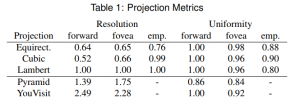Resolution-Defined Projections for Virtual Reality Video Compression
1. Introduction
In this paper, the writer analyzes the resolution distributions resulting from common projections used in VR video and compares them to custom projections that they have generated by aiming to match a desired resolution distribution.
Popular projections used for VR video benefit from mathematical or geometric simplicity, but result in suboptimal resolution distributions, including:
(1)the equirectangular projection, which results in that the spatial resolution of equirectangular images increases toward the poles;
(2)the cubic mapping, which sacrifices adjacency (there is no rectangular arrangement of the faces of a cube such that adjacency is maintained);
(3)the pyramid projection, which undesirably increases away from the forward viewing direction towards the corners of the pyramid base.
Having recognized these disadvantages, the writer proposes a method for generating a projection to match a desired resolution function. It allows for customized projections with smooth, continuous and optimal resolution functions, and it drastically improve compression ratios for any given quality.
2. Method
(1)Define the projections by the mapping equations of x, y, z as functions of u, v, w;
(2)Use an existing rectangular projection as a seed for deriving our new projection, guaranteeing that our final projection maps the unit sphere to a rectangle;
(3)Solve a set of single-variable first-order differential equations to derive the final projection.
3. Results
By re-deriving the Lambert Equal-Area Cylindrical projection as a projection with uniform resolution, the resolution on the horizon has been 57% better than the equirectangular projection.
Using a resolution function similar to that of the human eye, this method derives a nearly optimal projection, which peaks in the forward viewing direction, with resolution smoothly decreasing in all directions, and outperforms other projections derived for adaptive resolution in VR delivery
In order to quantitatively compare the projections, the writer has calculated the total resolution and total uniformity, then displayed the results in Table 1. The statistics suggests that the projection created by this method outperforms the others.

4. Conclusion
The resolution-defined projections are defined analytically, as opposed to geometrically, making them flexible and primed for future improvements like context-based encoding on a video-specific basis.